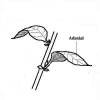Back to Aeronautics and space science ...
......
SPECTRAL COMPOSITION OF LIGHT AND
GROWING OF PLANTS IN CONTROLLED ENVIRONMENTS
(...)
Optimal photosynthesis of plant leaves involves a harmonious relationship between spectrum and the
intensity of PAR.
Thus, plants "work" to obtain the maximum photosynthetic efficiency
(but the photosynthesis is not maximum for each leaf) (Tooming, 1984).
There is a question.
Is it necessary to prepare optimal light conditions for the photosynthesis of all
leaves on the plant or not?
What way is it determined?
The correct'decision on spectral composition of light depends very much
on certain morphological characteristics of plants. There is a dependance upon
the distribution of fruits (- NOTE: ..Or flowers... ) along a stem (Tikhomirov, 1990).
For example, cucumber has equal distribution of fruits along the stem.
There every leaf supplies assimilate to its fruit. In this connection
cucumber leaves at all layers must be provided with optimal light conditions. This requires a large
portion of green rays in PAR (about 40%). Red rays in PAR (about 40%) provide high level of
photosynthesis of upper leaves. Green rays penetrate into middle and lower leaves of plants. Blue rays
have regulatory function, but its part in PAR is not very big (about 20%) (Tikhomirov, 1989).
We have another situation, where fruits of a plant concentrate in the upper part of the stem. Classical
example is wheat. The ear of wheat is supplied with assimilates, primarily from the upper leaves. With
this crop, PAR must have approxinlately 60-70% red rays (Tikhomirov, 1990). We've obtained data on
specific reactions of plants for the spectral composition of PAR. It's particularly important during plant
development processes. According to this point of view plants may be divided into two groups
(Tikhomirov et al., 199 1):
1) The first group is characterized with restricted growth and development processes at
definite ontogenetic phases if the PAR spectrum and intensity are not optimized (i.e.,
cucumber, sunflower);
2) The second group include plants capable of passing through all ontogenetics phases and
producing a harvest irrespective of the PAR spectrum and intensity provided (for example:
tomatoes, wheat).
Wheat is capable of passing through all phases of ontogenesis regardless of any specific spectral
irradiation. It's correct for PAR range of 100-600 W m-2 and possibly even higher. Tomatoes have more
restricted PAR range in comparison with wheat. With a PAR of 200 Wm-2 and higher, tomato
productivity is lowered in red rays. PAR range for radish appeared to be more narrow. Even when red
and green light is equal at a PAR of 200 Wm-2,plants of radish perish. Cucumbers appeared to be the
most greatly influenced by the spectrum of PAR. For example in red wavelengths with less than PAR of
50 Wm-2, plants die.
We shouldn't ignore these great differences in reaction of plants on spectrum and PAR intensity.
All compromising decisions including
introduction of universal spectrum of irradiation
lead to partial loss of productivity.
(..)
And continues like ....
(...)
Equal-energetic spectrum ("white" light)
or
a spectrum similar to curve of the action spectrum of
photosynthesis (NOTE: Not the absorption specrum ,here . Ok ?)
have been proposed for use as a universal spectra for plants growing under lamp lighting.
The first might be chosen because of consideration of phylogenesis of plants, the second - because of
research familiar to you (McCree, 1972; Inada, 1976).
Either of these options could be accepted as a temporary compromise for initial research.
I do not believe that we have to copy illumination of plants
in natural conditions for use in controlled environment growing.
(Note :I'm joining the club,also . Me too ! )
For example there's no need to grow some species of plants under alternative
light dark periods.
Our research showed that productivity of some plants (radish, wheat) can be
increased under continuous irradiation (Tikhomirov et al., 1976; Lisovsky et al., 1987).
Also, we should not strictly aspire to duplicating morphophysiological characteristics of field grown plants. Thus,for example, we achieved a very large radish productivity when we sharply changed its
photomorphogenesis(T ikhomirov et al., 1976). This is true for increasing cucumber productivity too.
However, if we accept this concept, we must know where and how we should deviate from natural
conditions to increase productivity of plants grown in controlled environments.
(..)















